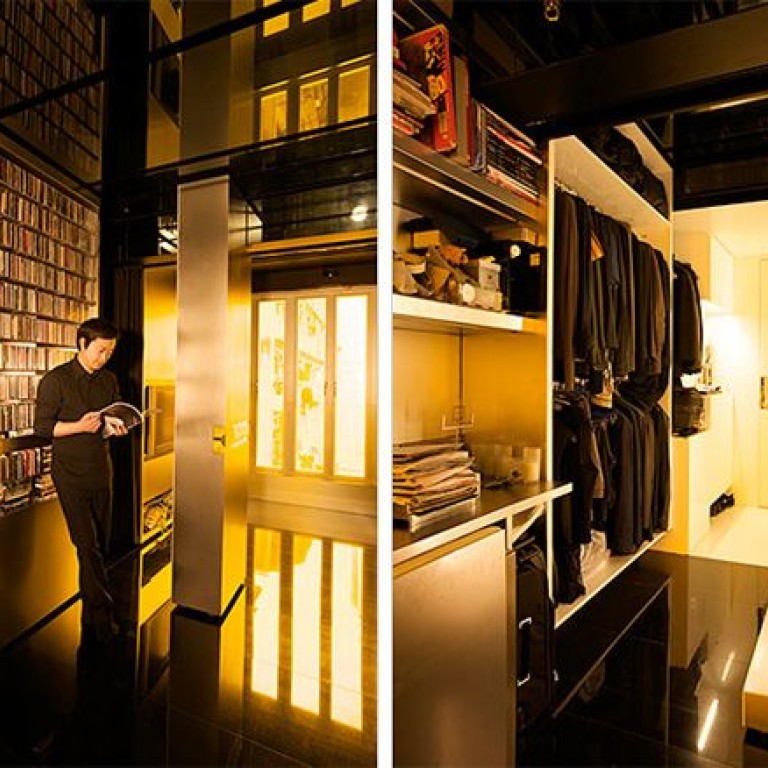
Furniture of the future
RoomBots, furniture that can transform by itself, could soon be coming to a smart home near you.
Ever since Hong Kong architect Gary Chang publicly experimented with flexible living concepts in 1988, the design world has had a curious fixation with fitting more into less.
The Japanese had been doing it quietly for years, of course. But “Domestic Transformer”, the catchy name that Chang, founder of the Edge Design Institute, gave to a 344 sq ft Sai Wan Ho flat which can be configured into at least 24 different layouts, due to sliding wall units, fold-down tables and pull-out cabinetry, has been widely documented, and is still referred to in design articles today.
In the era of micro-apartments, his ideas struck a chord. Spanish firm Elii Architecture renovated a small Madrid attic so that all the furniture is hidden, leaving the limited floor space clear. At mealtimes, a table and dining bench lower via pulley system from a ceiling cavity. Storage space in the “Didomestic” is concealed in the bathroom floor; and a cubby hole in the bedroom opens to reveal a tea nook. There’s even a fold-out swing, a hammock and a hidden disco ball – because every modern home should have one.
Even in Australia, where people feel compelled to cram into cities despite abundant land, inner-city space comes at a premium. Rothelowman, an architecture and interior design firm, has responded with its blueprint for “Convertible Spaces”, a project designed to address this lifestyle shift.

In the Melbourne development under construction, beds fold into the wall Murphy-style to free up floor space; and movable walls enable residents to change their apartment to suit their needs. The flat’s feature wall, which can be moved around at will, contains a TV unit, a kitchen with fridge, bedroom wardrobes and bedside tables.
Chris Hayton, principal architect at Rothelowman, says the design concept – inspired by Japanese urban living solutions – will “raise the standard for large-scale inner city urban housing developments”.
At the Milan Furniture Fair in Italy in April, new designs showed how far the concept of multifunctional interiors has come.
"Research and development, innovation, patented technology and a creative spirit is what transforms a dwelling into an intelligent home," says Clei, unveiling its folding kitchen and Murphy bed combo, the Kitchen Box. In daytime dining mode, the kitchen folds out and a counter folds down, acting as a servery through to the dining area. The kitchen component includes a sink, induction hob with two burners, a fridge, dish washer, microwave and rangehood. A good amount of storage is provided.
A year earlier, Clei launched its Ecooking Vertical Kitchen, a tiny but fully equipped kitchen where every component folds away to form a neat, vertical stack. The brainchild of Italian designer Massimo Facchinetti, the unit packs in a refrigerator and freezer, sink, four-burner induction cooktop, air vent, dishwasher, storage space, counter tops – even a herb garden fed by the washing-up water – all within a 70cm by 70cm footprint. The individual components swing out as needed, and tuck neatly back into their cubby hole when you’re done. There’s even a solar panel to help power the electrical appliances. Its creators say the design is a practical vision showing what can be fitted into a small apartment in a way that's neither cluttered nor cheap-looking.

Also at Milan in April, Italian brand Campeggi showcased its latest multifunctional furniture that allows users to continually redesign their living space, using the same pieces in different ways. There’s the ABC modular sofa, designed by Giulio Manzoni, which transforms from a family lounge into a single, double or even twin bed set in a few simple steps.
Another of Campeggi’s new designs is Gilbert & George, by Denis Santachiara, a large ottoman composed of two elements which fit together, and can be converted into twin rocking chairs or individual lounges. Nessy, designed by Emanuele Magini, is a flexible sofa with an unusual “tail” that can move around to make various shapes.
But what if you wanted your furniture to transform by itself? Boffins in Switzerland are working on that, too. RoomBots, under development in the Biorobotics Laboratory at the Ecole Polytechnique Federal de Lausanne (EFPL), are domestic robots that sync to one another via home Wi-fi to change into new shapes or structures. A table could become a chair, for instance – or vice versa.
Connected RoomBots could also move around the room to different locations. When you don’t want that occasional table, they morph into a static structure, such as a wall.
RoomBots have been called the “furniture of the future” – perhaps coming soon to a smart home near you.

